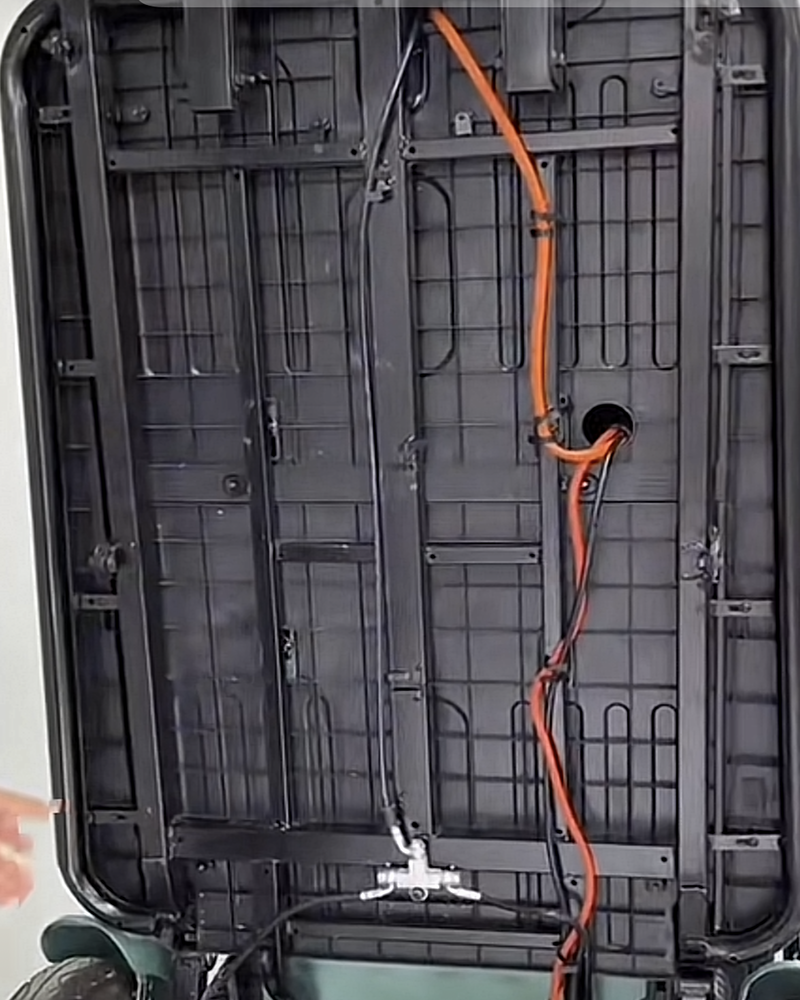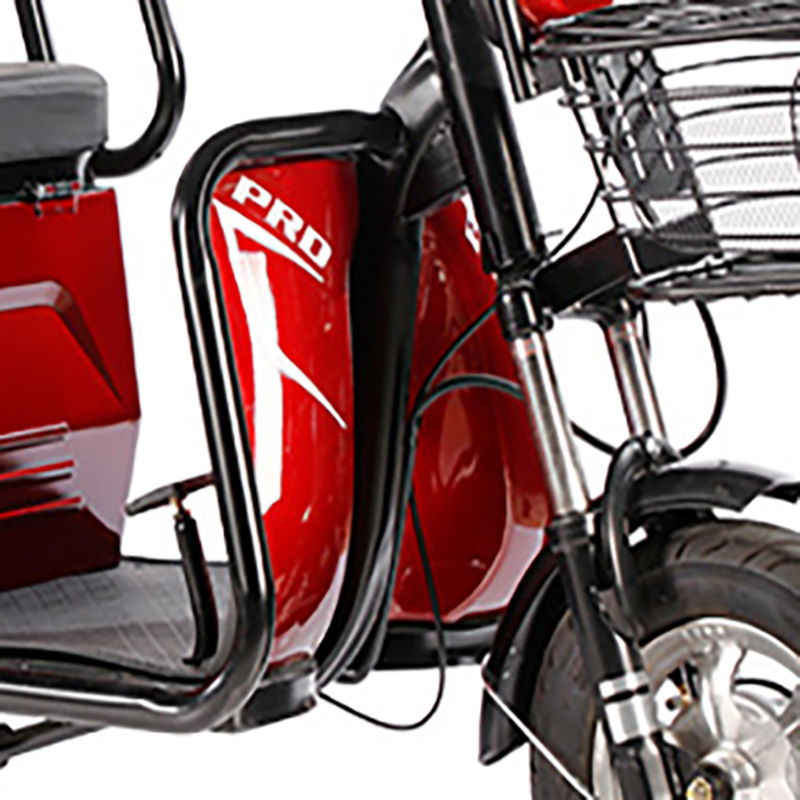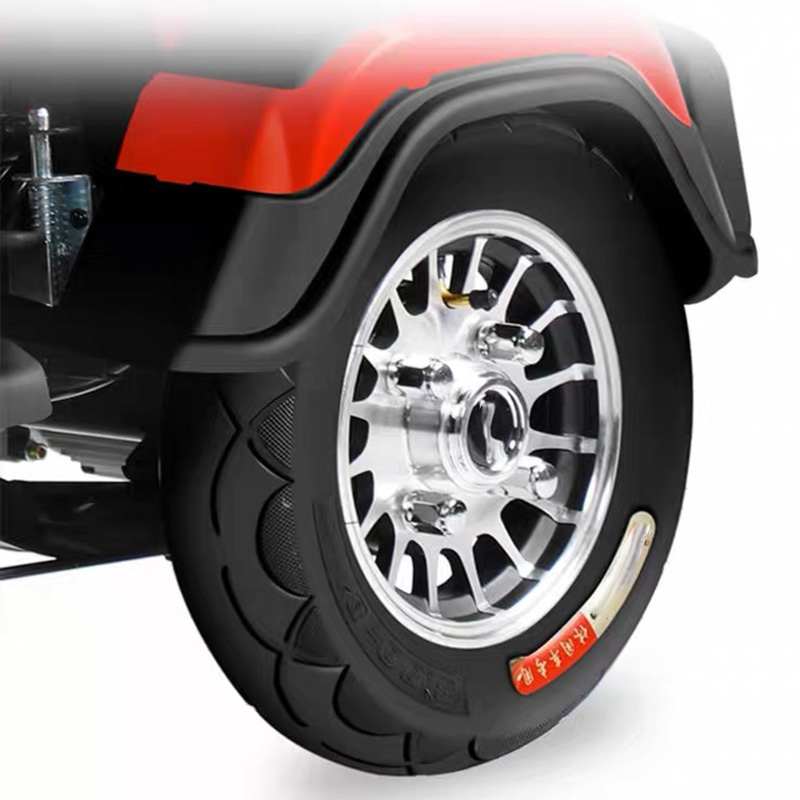
Leisure E-Tricycle Manufacturer
AGL-TRIKE welcomes bulk purchasers to a world where quality meets quantity in electric leisure tricycles. We, as manufacturers, assure not only a steady supply but also a realm where every tricycle is customizable to your market needs. Elevate your inventory with our precision-crafted, comfortable, and superiorly stable tricycles, and let’s steer towards a future of mutual growth and success.
Table Of Contents For This Page
To make sure you can find the information about all aspects of custom Leisure electric tricycles you want quickly, we have prepared this content directory that will jump to the corresponding location when you click on it.
Exploring Varieties in Leisure Electric Trikes
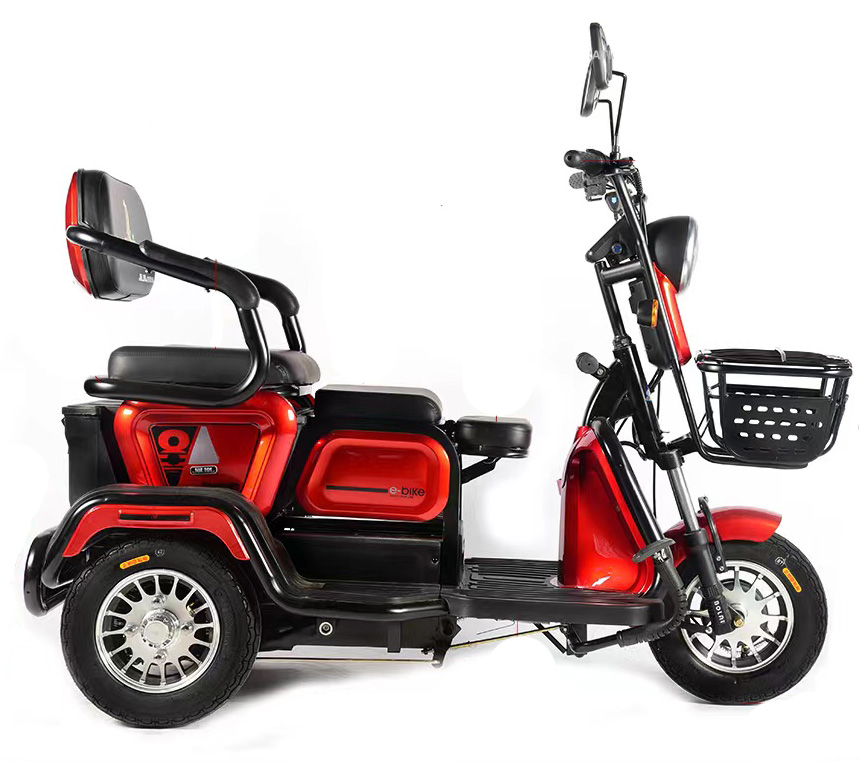
Features:
Move the seat back and forth and flip the front seat to carry two people fortravel. Hidden child seat, effectively protect the baby’s safety, avoid weight-lessness,can take three people.

Frectures:
Small Double-Row E-Trike ;Medium Double-Row E-Trike ;Large Double-Row E-Trike 3 Size daptable to various use-cases and customizable to your specific needs
Driving System: Powering the Electric Leisure Tricycle
In the world of leisure tricycles, brushless motors reign supreme, each type offering unique advantages tailored to varied user requirements and budgetary allowances

Motor Details
BLDC Motors:
- Economical Choice: More budget-friendly, these motors serve as an accessible entry point into the leisure tricycle market.
- Noise Level: Notably, they tend to produce a noticeable hum or whir during operation, which might be perceptible in quieter environments.
PMSM Motors(sine wave motor):
- Premium Performance: While carrying a higher price tag, they ensure a power-packed, smoother, and quieter ride.
- Enhanced Durability and Torque: Not only ensuring a sturdier and more stable ride, but PMSM motors also promise a longer lifespan and robust torque, sustaining power in various terrains and usage scenarios.
At AGL-TRIKE, we guide you through these motor options, ensuring you secure a model that adheres to your specific needs, usage, and budget, crafting a leisure tricycle experience that’s uniquely yours.
key Parameters of the Motor
Understanding Motor Power: The kind and strength of the motor you choose will shape the tricycle's operational efficiency and general functionality.
| Rated Power (W) | Recommended Usage Scenarios |
|---|---|
| 500W to 650W |
Perfect for Single and Small Dual Row E-Trikes: Cater well to single-row E-Trikes and compact dual-row models, offering a blend of economical power and smooth riding. Safety and Stability for Elderly Scooters: Especially chosen for elderly leisure scooters, these motors ensure a safe and stable ride, without overwhelming speed. Effortless Navigation: Seamlessly conquer urban terrains and gentle slopes with our 500-650W motors. |
| 800W |
Enhanced Power and Versatility: Offering a robust riding experience and the ability to handle additional weight and varied terrains. Excellent Uphill Performance: Capably handles steeper inclines up to 30 degrees, making it an optimal choice for double-row leisure trikes, ensuring smooth and powerful ascents even on challenging slopes." |
| 1000W and Above | Optimal Power and Capacity: Ideal for scenarios demanding maximum power, such as challenging terrains or carrying heavier loads. Particularly suited for double-row leisure trikes, accommodating not only the driver but also an additional two adults. Though providing exceptional force, these motors are less commonly utilized in leisure models, considering their power may surpass typical leisure tricycle requirements. |
Understanding Torque (Nm): It's the measure of "force" driving a vehicle's initiation and its capacity to ascend inclines.
When selecting an electric tricycle, torque – the driving force that propels you forward and up inclines – is a critical consideration. Here’s what you need to know:
Performance in Perspective: While it’s true that higher-powered motors often deliver more torque, essential for heavy-duty tasks like hauling, leisure tricycles operate within a different context. They’re primarily designed for comfortable, everyday use rather than heavy lifting or navigating exceptionally challenging terrains.
Efficiency over Excess: Many leisure tricycles equipped with 500W motors can smoothly and efficiently ascend slopes without strain. For the typical user, riding through parks, neighborhoods, or city streets, this level of power is not only adequate but also optimal, ensuring a blend of performance, energy conservation, and battery longevity.
- Tailored to Task: Selecting the right motor is pivotal for the desired riding experience. Carrying adult passengers frequently, consider a stronger motor for consistent performance. However, for leisurely rides with good road conditions, especially by seniors, a smaller motor suffices. It offers the perfect blend of speed, comfort, and efficiency without unnecessary weight or costs
Speed (RPM): The tricycle's top speed is gauged by its rotation speed.
While an increased RPM usually indicates a swifter maximum speed, other elements such as transmission mechanics, tricycle weight, and carried load can affect actual results.
Choose AGL, and we will guide you in selecting the complex motor power and types, ensuring your vehicle achieves optimum efficiency and performance.

Controller Details
The controller functions as the heart of the drivetrain, directing appropriate current to the motor in line with throttle guidance. Its role is crucial in setting both acceleration and peak speed.
Safety Measures: These encompass protections like overcurrent, low voltage shutdown, and thermal safeguards
key Parameters of the Controller
When selecting a controller, it’s also important to ensure compatibility with the motor. If the motor is a sine wave motor, then a corresponding sine wave controller should be chosen.
Max Current Output (A): Represents the utmost power supplied by the controller to the motor.
Voltage Specification (V): Needs to align with the battery’s voltage.
Voltage Types: Available in 36V, 48V, 60V, 72V and so on, with 60V frequently preferred.
Classifications by Power Transistors: Controllers are available in configurations with 9, 12, 15, 17, 18, 24, 36 transistors, and more. The number of power transistors indicates the matched motor power:
- 9 Transistors: Ideal for riders who prioritize a more relaxed pace and efficiency.
- 12 & 15 Transistors: Suitable for those seeking a bit more speed and performance. While they deliver a more dynamic ride, they come at a slightly higher price and consume more power.
Choosing a controller with the appropriate specifications, we can ensure the motor receives the correct current, optimizing the acceleration and top speed of the electric leisure tricycle.

Choice of Rear Axle for Leisure E-Tricycles
The rear axle is pivotal to a leisure tricycle’s performance. It provides stability and balance, ensuring relaxed and smooth rides across varied terrains. Choosing a quality rear axle enhances your leisure tricycle’s reliability for comfortable and memorable journeys. Your selection ensures every ride is a blend of efficiency and safety.
Integrated Rear Axle (with Differential)
Advantages:
- Compactness: Simplified design and easier installation.
- Reliability: Fewer connecting parts mean potential for increased durability.
- Versatility: While leisure tricycles don’t require extreme load-bearing capacities, the integrated axle offers flexibility for occasional heavier loads or additional passengers.
Disadvantages:
- Maintenance: If components like the differential need attention, the entire axle unit might necessitate repairs or replacements.
- Size and Clearance: The integrated axle is bulkier than the segmented rear axle. Given the lower chassis of most leisure tricycles, there’s limited space, making the integrated rear axle a less frequent choice.
- Cost: Tends to be pricier than its segmented counterpart.
While the integrated rear axle can be found in leisure tricycles, its application is rarer due to the tricycle’s design and primary usage intentions.
Segmented Rear Axle (with Differential)
Advantages:
Maintainability: Designed for ease of maintenance. The modular nature allows for specific damaged parts to be replaced, preventing the need to overhaul the entire system.
Cost-Effective: Generally less expensive, providing a balance between quality and affordability, especially for family users.
Adequate Load-Bearing: While it might have a lower capacity than integrated axles, for adult leisure riders and occasional additional passengers (like children or another adult), it meets the day-to-day needs efficiently.
Disadvantages:
- Regular Maintenance: Due to its multi-component design, periodic checks and maintenance might be required more frequently to ensure optimal performance.
The segmented rear axle offers a balanced blend of cost-effectiveness and functionality, making it a go-to choice for many leisure tricycles designed for adult riders and family outings.
At AGL-Trike, we pride ourselves on our flexibility and adaptability. Catering specifically to international wholesalers, we tailor our offerings based on your budget and unique requirements. With our profound expertise as a leading electric tricycle manufacturer, we’re committed to delivering solutions that align perfectly with your needs.

key Parameters of the Rear Axle:
The gearbox, centrally situated within the rear axle, not only connects the two wheels via half-shafts but also forms a crucial link to the motor.Serving as a crucial drive and transmission device.
Inside the gearbox lies an integral component – the differential. Through the internal gears of the differential, the power driven by the motor is conveyed to the two half-axles, allowing each wheel to rotate at different speeds. This unique design ensures that, when the leisure trike turns, the wheels can travel different distances, maintaining stability and smoothness.
The gear ratio inside the differential determines how power is transferred from the motor to the wheels. This transmission ratio directly impacts the trike’s initial thrust, top speed, and energy efficiency. Due to the differential’s outstanding torque transmission capability and its powerful uphill and load-bearing capacity, it is widely used in leisure trikes. It’s not only the essence of the rear axle but also plays a vital role in optimizing the overall performance of the trike.
Gear Ratio:
As depicted in the illustration, the differential houses a relationship between the number of teeth on the drive gear (usually linked to the motor) and the driven gear (commonly attached to the wheels).
For example:
- With a 3:1 gear ratio, the drive gear (from the motor) revolves 3 times to make the driven gear (at the wheel) turn once, giving higher speeds at the expense of load-bearing capacity.
- In contrast, a 5:1 ratio ensures the drive gear rotates 5 times for each single spin of the driven gear, optimizing for strength and pulling power, albeit at reduced speeds.
Imagine two electric tricycles, each with the same motor attributes but distinct differential ratios. One sports a 31:10 ratio and the other, a 35:14. The tricycle with the 35:14 ratio can outpace its counterpart by a minimum of 10 km/h, but compromises on its hauling prowess.
When assessing an electric tricycle’s emphasis on speed versus power through its differential ratio: a diminished ratio implies a leaning towards speed, while an augmented one points to an emphasis on torque and strength.

Within our establishment, every gearbox is crafted with precision and care, aiming to deliver optimal performance across our range of electric tricycles. Our unwavering commitment ensures effective and consistent power transmission from motor to wheels, promising both exceptional functionality and extended durability for your trike!
Battery Essentials for Leisure Tricycles
When choosing a leisure electric tricycle, battery endurance is paramount. Ensure a battery that not only offers extended range but also promises a long lifespan for countless adventures ahead
Lithium-ion vs. Lead-Acid: A Comparison
| Parameter/Voltage | Lithium-ion Battery | Lead Acid Battery |
|---|---|---|
| Purchase Price | Higher initial investment cost | Generally more affordable but might require more frequent replacements |
| Safety and Stability | Can be more volatile under conditions like overcharging but usually comes with advanced Battery Management Systems (BMS) for protection | More stable |
| Weight | Lighter and more energy-dense, making them suitable for portable applications | Compared to lithium batteries of the same capacity, it has a larger volume and is heavier |
| Lifespan | Generally offers longer lifespan with a higher number of charge-discharge cycles | Shorter lifespan and degrades faster after a certain number of cycles |
| Charging Speed | Faster charging capabilities | Slower charging times |
| Range and Performance in Cold Conditions | Retains a decent performance in cold temperatures, but range can be slightly diminished | More susceptible to performance drops in colder climates, resulting in reduced range |
Both lead-acid and lithium batteries are commonly used in leisure trikes. Your choice can be based on your budget
Battery Capacity Choose
| Parameter/Voltage | 48V | 60V |
|---|---|---|
| Battery Quantity | 4 batteries | 5 batteries |
| Common Capacity | 20Ah, 32Ah,45Ah | 32Ah, 45Ah |
| Recommend Capacity | Recommend using capacities of 32ah and 45ah. This is because a capacity of 20ah provides a limited range of around 40KM. If the vehicle is used frequently, constant charging will accelerate battery aging and reduce its lifespan | recommend using 32ah. If there's a need to opt for 45ah, certain requirements for the vehicle type must be met. This is because the 45ah battery is relatively large in size, and many leisure trikes may not have sufficient battery storage space |
| Cruising Range | 50-90 kilometers | 50-100 kilometers |
For leisure trikes, 48V and 60V batteries provide ample power for most riders without the need for excessive speeds. However, should you have specific customization requirements, don’t hesitate to reach out. At AGL-Trike, we’re committed to delivering the best solution tailored to your needs
Other Key Parameters about Batteries
- Brand Credibility: Top-tier brands often denote a stamp of quality and dependability, having endured stringent quality evaluations and earned their stripes in the marketplace.
- Production Date: Batteries with a more recent manufacturing date generally promise longer lifespan and more consistent performance.
- Security Protocols: It’s vital to select batteries fortified with protective measures against issues like overcharge, over-discharge, and electrical shorts.
- Battery’s Location and Weight: Both these factors play a pivotal role in maintaining the vehicle’s balance. It’s essential to choose a battery that complements the design of the vehicle for maximum stability.
When it comes to battery selection, it’s crucial not to simply chase after the highest voltage and capacity. At AGL, we’re here to guide you in determining the right battery setup tailored to the real-world usage scenarios of your electric tricycle’s intended market. By harmonizing the perfect balance of motor power and usage demands, we’re committed to delivering peak tricycle performance. More than that, we ensure your investment garners value, maximizing the cost-to-performance ratio.
Leisure Electric Trike Suspension System Overview
Front Suspension System
Fork Shock Absorber
Choosing the right front suspension is crucial for a comfortable ride, especially over uneven terrains. A quality suspension can significantly reduce fatigue during extended rides, ensuring every journey is a pleasure.
Material Choices:
- Steel: Durable and often more affordable.
- Aluminum Alloy: Lighter and may offer smoother performance, but typically at a higher price.

Genuine Hydraulic Damper Front Fork:
- Performance: Offers superior shock absorption. Its fluid-based mechanism ensures smooth rides even over bumpy terrains.
- Durability: Built with high-quality materials, it’s designed to last and requires less frequent maintenance.
- Price: Tends to be more expensive due to its sophisticated design and better performance.
Mock-Hydraulic Damper Front Fork:
- Performance: Provides basic shock absorption. While it mimics the appearance of a hydraulic system, its performance can’t match the genuine version.
- Durability: May wear out faster due to the compromise in design and materials.
- Price: More budget-friendly, making it common in lower-priced tricycles.
Length and Diameter – A Subtle Yet Significant Factor:
While the material and type of front fork suspension largely determine its performance, one must not overlook the importance of its length and diameter. These dimensions can significantly influence not only the tricycle’s aesthetic and stance but also its price.
For those targeting a more premium market segment, it’s crucial to recognize and opt for superior front fork configurations during procurement. The choice of front fork not only influences ride comfort but also adds value to the product’s perceived quality and performance.
Rear Suspension System
The tricycle’s rear is where the rider or riders sit. A quality rear suspension ensures that they remain insulated from the jarring impacts of uneven terrains. Whether it’s a leisurely ride in the park or a journey across cobblestone streets, the rear suspension system cushions the blows, ensuring that riders feel minimal disturbance.
Damping Hydraulic with Coil Absorber
In the realm of leisure tricycles, the combination of Damping Hydraulic and Coil springs stands as the most popular rear suspension choice. This tandem offers a unique blend of comfort and control, ensuring riders enjoy a smooth experience, regardless of the terrain.
Advantages:
- Harmonized Absorption: While the coil springs handle initial shock absorption, the hydraulic damping refines the process, curbing any post-shock oscillations.
- Versatility: This pairing adeptly manages a wide range of terrains, ensuring both minor road imperfections and larger bumps are comfortably navigated.
- Longevity & Durability: The dual system enhances the tricycle’s lifespan by distributing the stress between two components, thus reducing wear and tear on each.
Key Parameters:
- Damping Rate: Crucial for dictating ride comfort. An optimized damping rate ensures that the tricycle has stability during rides, without sacrificing the plush feel.
- Spring Rate: It’s pivotal in determining the tricycle’s responsiveness. The right spring rate ensures that the tricycle remains grounded without being too stiff.
- Material Selection: Using materials like durable steel for the hydraulic system and coil springs guarantees consistent performance and longevity.
- Adjustability: The ability to fine-tune the damping hydraulic and coil spring settings can be beneficial for adapting to different terrains or rider preferences.
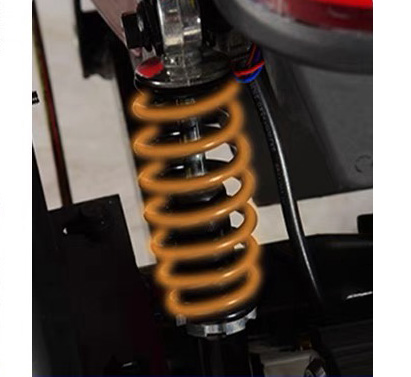
The quality and effectiveness of a suspension system aren’t solely dependent on the specifications of the shock absorbers.
The structural design of the suspension itself plays a pivotal role in enhancing ride comfort. For instance, both Figure Two and Figure Three showcase independent suspension systems, which inherently offer a superior riding experience compared to traditional designs. Furthermore, Figure Three, equipped with two additional shock absorbers, promises an even more refined and smoother ride, optimizing comfort and performance.
At AGL-Trike, beyond our standard offerings, we tailor solutions to match your specific needs and the unique demands of your local market. With your vision and our expertise, we’re committed to turning your ideas into reality, ensuring a perfect alignment with your objectives and constraints.
Frame &Structure of Electric Leisure Tircycles
Primary Frame Material – Steel
- Thickness: The steel frame thickness in leisure tricycles typically ranges between specific millimeters. It’s vital to consider the frame’s thickness as it directly affects durability and weight.
Finish – Baked Paint
- Protection and Aesthetics: The baked paint acts as a protective layer, shielding the steel frame from potential rust and wear. Additionally, it provides a polished and sleek appearance to the tricycle.
Frame Construction:
- Integrated Molding (One-Piece Bottom Plate): Offers a seamless design, often resulting in a more aerodynamic frame. It gives the tricycle a refined and clean look.
- Welded Design (Welded Bottom Plate): Allows for certain adaptability and ensures stronger joints. Welded frames ensure robustness and can cater to diverse design preferences.
Chassis Integrity:
- Beam Density and Thickness: Increased beam density and thickness make the tricycle more resistant to stresses and enhance its overall lifespan.
Mudguards and Windshields Material:
- Plastic: Lightweight and corrosion-resistant, making it a practical choice for many tricycles.
- Metal: Offers enhanced durability and a more classic appearance.
Brake System in Electric Leisure tricycles
Selection of Brake Types

Drum Brakes
Attributes:
- Economical Choice: Drum brakes usually come with more affordable production and upkeep expenses.
- Braking Power: Their unique design can offer superior stopping force in specific settings.
- Ideal Usage: Often found in heavier-load vehicles, like cargo tricycles, drum brakes can furnish the requisite stopping strength.
Drawbacks:
- Heat dispersion is less efficient compared to disc brakes, potentially causing the brakes to overheat.
- They might exhibit a tad slower reaction time.
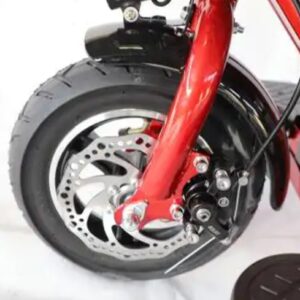
Disc Brakes
Attributes:
- Superior Heat Management: Disc brakes excel in dispersing heat, ensuring swift cooling and minimizing brake overheating risks. While there’s an upfront cost, their lifetime maintenance expenses can be more economical.
- Quick Response: Delivers immediate and uniform braking action.
- Best Fit For: Given their heat management and quick responsiveness, disc brakes are favored in vehicles needing fast stops and top-tier performance.
Drawbacks:
- They come with a heftier initial price tag.
- Potential for more regular upkeep.
Application and Standard Matching of Brakes
In today’s electric trike loader marketplace, drum brakes are a favored choice due to these factors:
Cost Efficiency: Drum brakes boast a more economical production cost compared to alternate brake systems. This cost advantage appeals to both manufacturers and buyers in the electric trike loader sector where getting the most value for money is a priority.
Reliability and Minimal Upkeep: With their straightforward design and extended durability, drum brakes allow users to save on both maintenance and replacements, ensuring their electric trike loader operates consistently and reliably.
Versatility: The structure of drum brakes is aptly suited to manage significant braking torque, making them the go-to choice for electric trike loaders tasked with heavy lifting.
There are various brake configuration options, as follows:
Triple Drum Brakes:
- Overview: All three wheels are equipped with drum brakes.
- Advantages: Drum brakes are traditionally more resistant to water and mud compared to disc brakes, ensuring consistent performance in various conditions. They are often more affordable and require less maintenance over time.
- Ideal For: Riders who prioritize consistent braking in varied terrains and conditions, without a need for rapid, high-intensity stops.
Front Disc with Rear Drum Brakes:
- Overview: The front wheel uses a disc brake while the rear wheels employ drum brakes.
- Advantages: The combination offers the quick response of a front disc brake with the consistent and reliable performance of rear drum brakes. This setup balances cost-effectiveness with enhanced stopping power at the front.
- Ideal For: Those seeking a bit more braking responsiveness at the front without compromising on the reliability of drum brakes at the back.
Triple Disc Brakes:
- Overview: All three wheels are equipped with disc brakes.
- Advantages: Disc brakes provide superior stopping power and heat dissipation, especially during intense braking scenarios. They offer a consistent braking experience across different conditions and are more responsive.
- Ideal For: Enthusiasts and riders who seek the utmost in braking performance, especially in situations demanding rapid stops or during downhill rides.
Choose ALG Trike, can ensure not only safe and stable braking but also accommodate various driving and budget.
Tire and Wheel Hub Essentials
Tire selection for a electric leisure tricycles
When selecting a leisure tricycle, the tire specification is a vital consideration, influencing both the ride comfort and the overall aesthetics of the tricycle. Typically, two main sizes dominate the market for leisure tricycles:
3.0-8 Size:
- Suited for those seeking a more compact wheelbase, this size provides good stability and is often found on tricycles designed for maneuverability in tighter spaces.
3.0-10 Size:
- A slightly larger option, it offers a smoother ride over varied terrains, especially beneficial when traversing minor road imperfections or bumpy paths
For example, if the tire parameter is “3.0-10”, where “3.0” represents the tire width, and “10” indicates the inner diameter of the tire. Generally, larger sizes are more expensive. For instance, a 3.0-10 tire will be pricier than a 3.0-8 tire.
Tire Material: Mainly, there are two types: Radial tire and Bias tire.Radial tire due to their strength, exhibit superior durability, especially under heavy load and long-distance driving. If comfort riding is the preference, Bias tire would be sufficient.
Tire Ply Rating: Common specifications include 4PR, 6PR, 8PR. These ratings represent the tire’s load-bearing capacity. The more the ply number, the stronger its load-bearing capacity will be.
Tire Shape: Tires mainly come in two shapes: flat-top and arched. Flat-top tires are thicker and more wear-resistant, suitable for bearing larger loads; whereas arched tires provide a more stable riding experience. Therefore, some three-wheelers might opt for arched tires in the front and flat-top tires in the rear.

Wheel Hub Material
Aluminum Alloy Wheel Hub: Aluminum alloy is popular for its lightweight, high strength, and good corrosion resistance. It can provide better heat dissipation, helping to reduce brake overheating, and offer a certain degree of weight reduction for the vehicle.
Steel Wheel Hub: Steel is a heavier but very sturdy and durable material. This type of wheel hub typically costs less, but its heavier weight may slightly sacrifice some performance.
Tires are the only point of contact between the electric tricycle and the ground, making the choice of suitable tires crucial. For smooth roads, we recommend choosing tires with low rolling resistance and a softer composition, offering better comfort and energy efficiency. On rugged or muddy terrains, tires with deep treads should be selected to ensure good traction.
Transport Packaging at AGL-Trike
Vehicle Delivery Packaging
At AGL-Trike, we pride ourselves on our attention to detail and our commitment to the highest quality in every aspect, right down to our packaging. To provide our clients with a visual understanding of our professionalism, we showcase several standard full-vehicle delivery packaging methods. Our approach ensures the utmost safety and protection for the product, ensuring it reaches you in pristine condition.
Basic Standard Sponge Packaging
Wooden Frame Packaging
Metal Frame Packaging
- Metal Frame with Wooden Crate Packaging

More Custom Packaging Options
Understanding that each client might have specific needs and preferences when it comes to transporting and assembly, we offer a range of packaging choices:
SKD (Semi Knocked Down): This packaging method involves partial assembly. Major components are packed separately, offering a balance between ease of transportation and reduced assembly effort at the destination.
CBU (Completely Built Up): The vehicle is fully assembled and ready for immediate use upon arrival. This method is ideal for clients who prefer a plug-and-play solution without the need for post-shipment assembly.
CKD (Completely Knocked Down): This involves a complete disassembly of the vehicle. Each component is securely packed individually, ensuring compactness and efficiency during transportation. This method is perfect for destinations with specific import regulations or for clients who have specialized assembly capabilities in-house.
By offering these diverse packaging options, we ensure that our clients can select a method that aligns perfectly with their logistics, assembly capabilities, and preferences. Our goal at AGL-Trike is to make every aspect of your purchase, including transportation and packaging, as seamless and tailored as possible.
FAQs on Wholesale and Customization of Leisure Electric Tricycles
What are the MOQ of the Order?
For optimal shipping cost, we advise filling a 20GP container. However, orders not filling a container are accepted with a note of higher shipping costs. Mix 1-2 different tricycle styles in a single container for variety and cost efficiency.
Ensure you get the best in shipping, cost, and variety with our flexible MOQ and shipping options.
What is the expected lead time?
For standard models, expect a lead time of 15-25 days. For special custom orders, delivery times are estimated based on your specific requirements, ensuring you know when to expect your order, and can plan accordingly.
What is the warranty period for your electric leisure tricycles?
We offer a 1-year warranty for our Leisure tricycles, covering any non-man-made damages. Rest assured that we stand behind the quality and durability of our products, providing you with reliable post-purchase support.
Do you ship internationally?
Yes, we ship our electric tricycles worldwide with trusted logistics partners.
Are your electric tricycles certified and compliant with international standards?
Absolutely, our tricycles adhere to international safety and quality standards, ensuring reliability and safety for all our customers.
How is the after-sales service?
We provide comprehensive after-sales service including spare parts supply, technical support, and other assistance to ensure the smooth operation of your electric tricycle.
Kickstart Your Project Now!
Got a project in mind or a question to ask?
Don’t wait! Our team is ready to help.
We’re committed to responding within 12 hours.
- +86 18367809612(Whatsapp)
- info@agl-trike.com
We will contact you within 12 hours, please pay attention to the email with the suffix “@agl-trike.com”.



